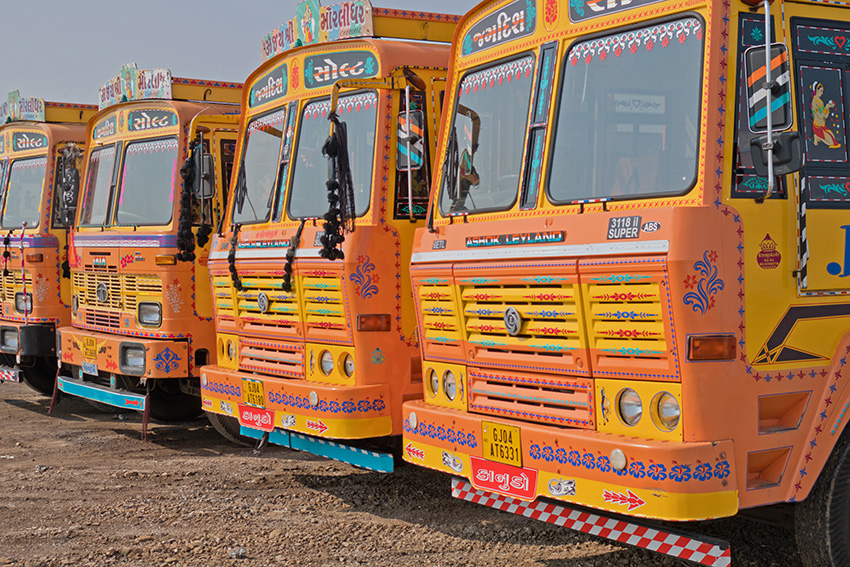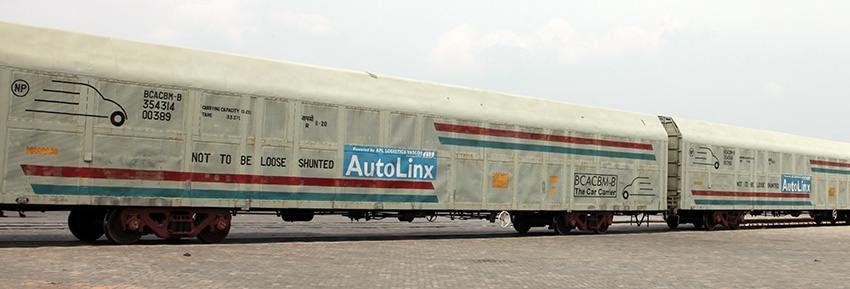 The Indian vehicle logistics market is in the midst of major change and disruption, much of it in the name of modernisation and improvement. New dimension and safety requirements for car carriers came into force in April, with carmakers and logistics providers scrambling to make their fleets compliant and secure new capacity. Meanwhile, this summer sees the implementation of the long-awaited Goods and Service Tax (GST) begin, which some expect will improve multimodal logistics and distribution. It’s a time of ‘all change’ – though some in the sector may be better equipped than others to keep up.
The Indian vehicle logistics market is in the midst of major change and disruption, much of it in the name of modernisation and improvement. New dimension and safety requirements for car carriers came into force in April, with carmakers and logistics providers scrambling to make their fleets compliant and secure new capacity. Meanwhile, this summer sees the implementation of the long-awaited Goods and Service Tax (GST) begin, which some expect will improve multimodal logistics and distribution. It’s a time of ‘all change’ – though some in the sector may be better equipped than others to keep up.
[in_this_story align="right" border="yes"]An enabling regulatory environment is something investors and businesses wish for, especially in emerging markets. So last year, when the Central Motor Vehicles Rules (CMVR) confirmed new standards for car carriers, it was generally welcomed by different stakeholders across the Indian industry. The new rules set maximum lengths for semi-trailer and drawbar trailer car carriers at 18.75 metres; they also require speed limiters to be fitted on such vehicles, restricting them to a maximum of 60kph (37mph), as well as the installation of rear-facing camera systems to reduce accidents and damage.
Before the new regulation, there was no standard length, with differing widths and trailer lengths varying up to 23 metres. These differences created disparity among transporters in terms of loading factors and economies of scale. While this was driven by economic motives – larger truck operators could enjoy higher earnings by loading more cars, while carmakers benefitted as they could load longer cars for the same rates as vehicles became larger and longer – it increasingly compromised road safety. There were a number of head-on accidents and trailers turning over, industry insiders report. The stability of such vehicles has been of particular concern, with sudden braking causing trailers to overturn – a major factor in the government crackdown.
“Now, since the size of the carrier is finalised, we can work on the innovation to improve the load factor inside the carrier,” says Vipul Nanda, chairman at Gefco-owned Mercurio Pallia, and president of the Indian Car Carrier Association (CCA), which represents 65 carriers covering some 95% of India’s 15,000-strong car carrier fleet.
[sta_anchor id="1"]“The uniform dimensions across the industry will help regulate the carrying capacity, fuel consumption and average distances covered in a day. This new standard will also eradicate those oversized carriers which posed an issue in navigation on the roads, putting safety in the back seat.”

A looming crunchThe new standard, which came into effect from April, is likely to create a significant shortfall in transport capacity in the short term. But it is widely seen as beneficial in the long run. Many in the industry agree that the disruptions that followed the enforcement of new regulations on car carrier dimensions – work stoppages and wresting of freight rate hikes by hauliers, as well as some confusion across the laws in different states – are part of the growing pains of a fast-developing vehicle industry.
However, the new rules have been causing reductions in outbound capacity, with the new standard equipment able to carry about 20% fewer vehicles than the previous non-standard trailers. Vehicle-carrying equipment for finished commercial vehicles, including trucks and farming equipment, as well as for India’s huge two-wheeler sector, is also subject to new dimensions.
For the automtovie industry, the new configuration enables carriage of only eight cars on trailers with a length of 18.75 metres, width of 2.6 metres and height of 4.75 metres. According to Anand Venkateswaran, senior general manager for sales logistics at Hyundai Motor India, the typical tractor-trailer configuration can take about eight small cars, depending on the product mix; but the average load is actually about six to seven cars, given the trend towards SUVs in India.
“What’s happened is that the ten-unit car carrier has become an eight-unit car carrier with a 20% drop in capacity,” Venkateswaran says. “With India’s auto industry growing at about 10% a year, the cumulative gap between demand and supply is 30%. Because of this gap, we are likely to face a shortage in transport capacity.
“The logistics capacity has to be in tandem with the country’s growth,” he adds. “If the market is going to continue with this growth rate, we’ll have a problem.”
Chandrakant Kadam, head of international logistics at Mahindra & Mahindra (M&M), believes the impact of any transport capacity shortage will be less pronounced on carmakers with export plants close to the coast, like M&M’s factories in Maharashtra. Companies delivering to the domestic market, especially those with long north-south movements, however, are more affected by the reduction in length and capacity.
So far, the industry has been coping with the changes, though experts agree that carmakers will feel the effects more strongly as the year progresses. Venkateswaran believes the demand-supply gap will widen in the second half of the year after the GST – the so-called ‘one nation, one tax’ regime – comes into effect, ensuring more standardised taxation across the country. With the long-awaited GST seemingly here at last, there has been a slight drop in the market, with confusion about how it will affect pricing. But most experts expect the prices of passenger vehicles to come down – significantly so for larger vehicles.
 "With India’s auto industry growing at about 10% a year, the cumulative gap between demand and supply is 30%. Because of this gap, we are likely to face a shortage in transport capacity." - Anand Venkateswaran, Hyundai Motor India
"With India’s auto industry growing at about 10% a year, the cumulative gap between demand and supply is 30%. Because of this gap, we are likely to face a shortage in transport capacity." - Anand Venkateswaran, Hyundai Motor India
[sta_anchor id="2"]Others worry about the start of the festive season this autumn, when demand for vehicles tends to increase. “There will be difficulty in getting car carriers when the festival season starts,” says the logistics manager at one big Indian truck and busmaker, who prefers to remain anonymous. “There’ll be more demand for cars, so sales will go up. The impact will be felt after September.”
A changing carrier fleetNanda says the industry is mostly prepared for the change, but that it will take time to balance capacity. “Right now, the industry is having to struggle because of the sudden drop in carrying capacity, which was in excess of 20-25%, and the capital cost for new carriers is high and [such investment] also involves significant time,” says Nanda. “Though transporters anticipated the shortage and started early to cope with the issue, it will take a good two quarters to establish an equilibrium. However, deliveries are being managed in a timely manner.”
To comply with new rules, transporters are reducing the size of their current equipment to meet regulations, and have begun placing orders for new equipment. Specialist trailer manufacturers are thus ramping up production.
According to Anand Singh, chief executive officer at Lohr India Automotive, a joint venture between France’s Lohr Industries and Transport Solutions of India, many vehicles currently in operation will simply be downsized and retrofitted, a process that should take about six months to complete. However, cutting the length to standard sizes will still leave the market short of capacity.
“This means additional capacity will have to be added, which should be done in the next 9-12 months. So there’s going to be good demand next year,” says Singh.
To meet rising demand, Singh says that Lohr India is building a new plant in Pune, a major vehicle production hub. The joint venture can currently produce about 25-30 vehicles a month and the new factory will almost double production to about 60 vehicles a month. “We expect complete deliveries will start by about September and a few truck fleet owners, who have understood there is opportunity now to bring in better quality and technology, have started placing orders for new vehicles. We have got an order for 250 car carriers,” reveals Singh.
[mpu_ad]Besides car carriers, Lohr India has also launched a new product called tractor carrier for agricultural tractors, since the transport of agriculture tractors in existing equipment will also be illegal, as they violate the width regulations of the Motor Vehicle Act. “This enabled us to get new orders, including an order of 200 vehicles, which means we have orders for almost 500 new vehicles in our order book,” Singh added.
[sta_anchor id="3"]As the two-wheeler market is also facing new requirements, Lohr has also developed triple-deck semi-trailers for carrying motorcycles and scooters; it will conduct field trials by the end of this month with selected OEMs.
Multimodal movementsUp to now, OEMs and logistics providers have faced numerous standoffs over the changing cost of vehicle logistics following the new regulations, including several incidents when hauliers had refused to move vehicles until rate hikes were agreed. The hauliers have said they have no choice but to demand price increases from OEMs since their costs have gone up. OEMs have ultimately agreed to rate hikes of about 25%.
“The carrying capacity is down and expenses to manage a carrier remain the same,” explains Nanda. “And let’s not forget the investment which the transport industry has to make for either the downsizing or manufacturing of carriers. Asking for rate increases from the OEMs was inevitable. It is very good on the part of OEMs that they have understood this and all of the OEMs have already agreed to the hike in rates.”
However, rate hikes will only go so far in redressing the capacity issue that the new regulations have created. Most in the sector agree that more vehicles will need to be transported by rail or ocean services, some of which may start looking more attractive as capacity on the road is squeezed and its costs rise. Currently, around 95% of vehicles in India still move by road, compared to 4% by rail and around 1% along its long coastlines, according to Hyundai’s Venkateswaran.
Due to a number of factors, the GST should help to promote multimodal transport, since vehicles can be stored more efficiently in mass in one state, and distributed to another without incurring extra taxes. That should make it easier to consolidate volumes for rail, for example.
State-owned Indian Railways has also been making moves to encourage car transport by train. Currently, there are two licensed users of specialised rail wagons in India – Maruti Suzuki and APL Logistics Vascor Automotive, the joint venture between APL Logistics and Vascor. APL Logistics Vascor has six rakes in operation and has ordered three more. However, carmakers don’t think it is enough, and still see a lack of capacity and services.
“For a modal shift from road to rail, that’s likely to take longer and won’t happen unless the rolling stock improves and more private rail operators enter the business,” says Venkateswaran.
 Despite investment by rail providers including APL Logistics Vascor Automotive, greater competition would be welcomed by carmakers to increase capacity and lower costs
Despite investment by rail providers including APL Logistics Vascor Automotive, greater competition would be welcomed by carmakers to increase capacity and lower costsSanjay Balachandran, head of autologistics and domestic business at Adani Logistics, expects some road-to-rail shift to take place given the capacity constraints in road transport. Adani currently offers containerised rail transport of cars and may not be an immediate beneficiary, as rates are not seen as attractive, with the gains more likely for the more specialised automotive rail carriers.
Although it currently has a lower market share, Venkateswaran believes the shift to sea will happen faster than it will to rail. He is encouraged that liner companies are showing keen interest in moving steel and cars in ro-lo (roll-on, lift-off) vessels, used for a combination of self-driven vehicles and general heavy cargo that needs to be lifted on or off.
“There have been some specific requests,” he says. “We can move steel in one direction and cars in another so the load imbalance factor can be overcome.”
The Indian government has also supported such services by changing port charges, which has allowed ports to offer 80% discounts on vessel-related charges for coastal vehicle movements.
Coastal shipping has some drawbacks, however. Hyundai Motor, which has a huge factory in Chennai, in southern India, has been moving cars by coastal shipping for almost a year, and Venkateswaran admits the transit times have been significantly longer than road transport. For example, Chennai to Gujarat, in north-west India, takes six days by road but at least 14 days by sea. If the firm has to move to the northern region, the coastal movement time is almost double – at least 15 days compared with eight days by road. Such timings lead to higher inventory costs, as well as delays to dealers and customers.
Another reason why coastal shipping has not been attractive is the lack of return loads. Hyundai Motor moves cars from Ennore Port (recently renamed to Kamarajar Port) in Chennai to Kandla port in Gujarat, and then by road to the north. But on the return journey, it does not have enough cargo from the north.
The passenger vehicle sector is not the only one to feel the squeeze from new equipment standards. Freight rates for truckmakers have also gone up about 15%, and these rising costs could make modal shifts more attractive. However, alternatives like rail and water could be more complicated, according to the anonymous logistics manager at the Indian truck and busmaker.
 Coastal shipping options have not seen much take-up due to longer transit times and the lack of backhaul opportunities
Coastal shipping options have not seen much take-up due to longer transit times and the lack of backhaul opportunities“So many co-ordination problems will arise – moving vehicles to the railway station, waiting for trains, moving to the destination and then unloading,” he says. “From OEM to destination, so many movements are [required] for rail.”
[sta_anchor id="4"]Road carriers, while in competition with other modes, agree that the industry will need to use more multimodal options. “India is slated to become the one of the automotive manufacturing front runners by 2020 as all the agencies are projecting steady growth in production of passenger vehicles for the Indian market,” says Nanda. “The government of India is also trying to promote multimodal networks. It is inevitable to branch out in more modes of deliveries to absorb the huge production we are anticipating by 2020.”
Better days aheadCar carriers will inevitably have to increase their fleets, but for many companies this may take as long as a year or more. Most transactions for transporters are in cash, and ongoing financial difficulties have made access to bank funding difficult. Many depend on more expensive, non-banking sources. And even then, few will buy entirely new equipment.
“Investment in a totally new fleet is probably still not viable since new carriers involve a very heavy capital cost,” explains Nanda. “Already car carrier companies have faced losses because of interest costs and heavy depreciation issues in the recent past. Companies will have to look into their debt versus equity ratios before any kind of investments in new fleets.”
New equipment will be needed, however, because some old carriers have had to be scrapped, including those with greater widths that make them uneconomic to modify. “There is an urgent requirement for new carriers to close up the gap between carrying capacity and the production by OEMs. Around 3,000-4,000 carriers are expected to be introduced in the next two years, which will increase the carrying capacity significantly,” Nanda adds.
Trailer manufacturers should be among the big winners from this transition and Anand Singh at Lohr India says new orders are already flowing in.
“We’re very happy that the CMVR rules and regulations are finally clear for the car carrier industry,” he says. “It has helped bring some amount of conformity and standardisation. This will help people like us who can bring good European technology to India and bring in more carrying capacity.”
In the long run, all should benefit. The solution to India’s capacity issues will come from a combination of new equipment, retrofitting, multimodal transport and finding new efficiencies, including better managing backhauls and empty returns. If it can get all this right, especially with GST in place, the sector will see many gains for its troubles.
 "Car carrier companies have faced losses because of interest costs and heavy depreciation issues. [They] will have to look into their debt versus equity ratios before any kind of investments in new fleets." - Vipul Nanda, Mercurio Pallia
"Car carrier companies have faced losses because of interest costs and heavy depreciation issues. [They] will have to look into their debt versus equity ratios before any kind of investments in new fleets." - Vipul Nanda, Mercurio Pallia





































